文章目录
决策树理论部分

决策树的思路很简单,就是从数据集中挑选一个特征,然后进行分类。
基本算法
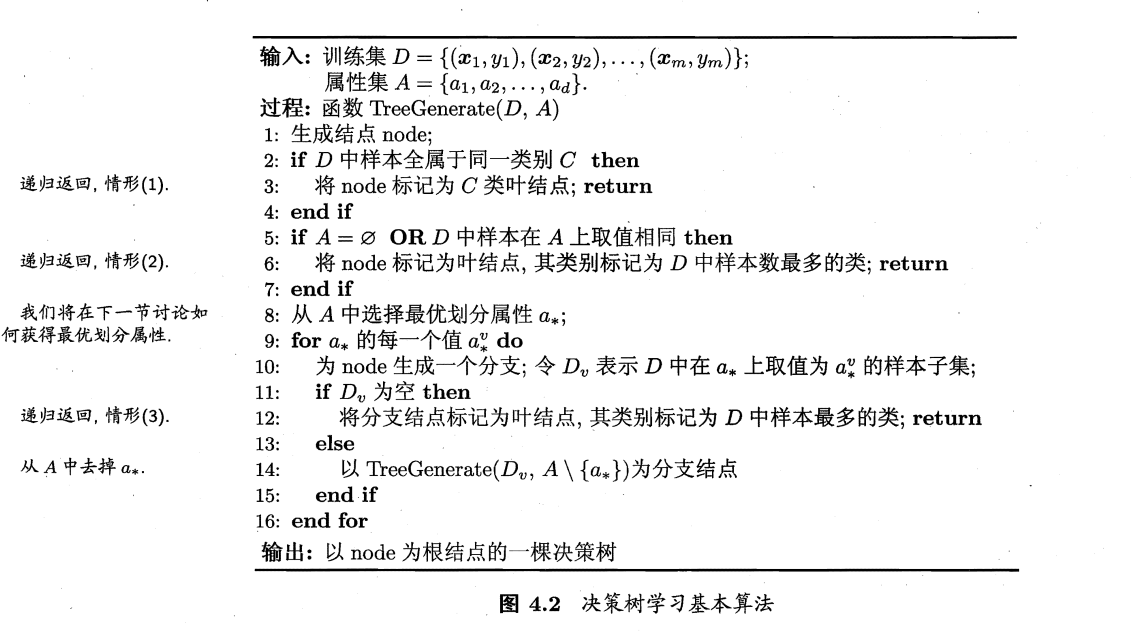
从伪代码中可以看出,分三种情况考虑:
(1)如果输入样本同属于一类,那么将节点划分为此类的叶节点。
(2)如果属性划分次数达到上限,即属性划分完了,或者是样本中在此类属性取值都一样,可以认为全部划分仍然存在不同类的样本,那么这个节点就标记为类别数占较多的叶节点。
(3)需要继续划分的情况,选择一个属性对数据集进行划分。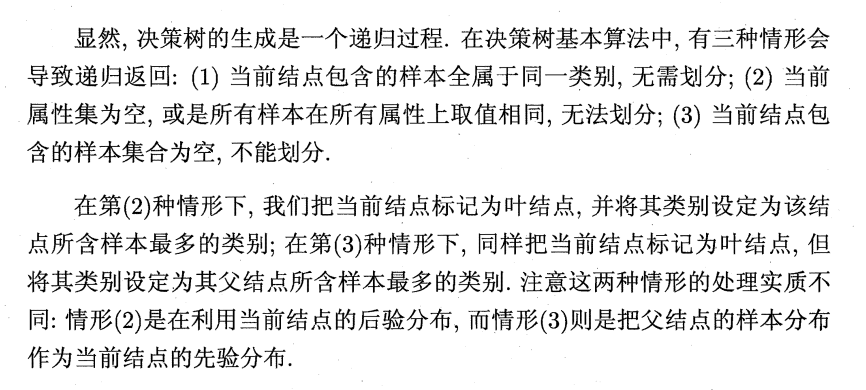
划分选择
划分选择还是比较重要的,因为不同的划分选择会建出不同的决策树。划分选择的指标就是希望叶节点的数据尽可能都是属于同一类,即节点的“纯度”越来越高。
信息熵

其中|y|是指样本标签的种类的个数,pk代表第k类样本所占的比例
信息增益
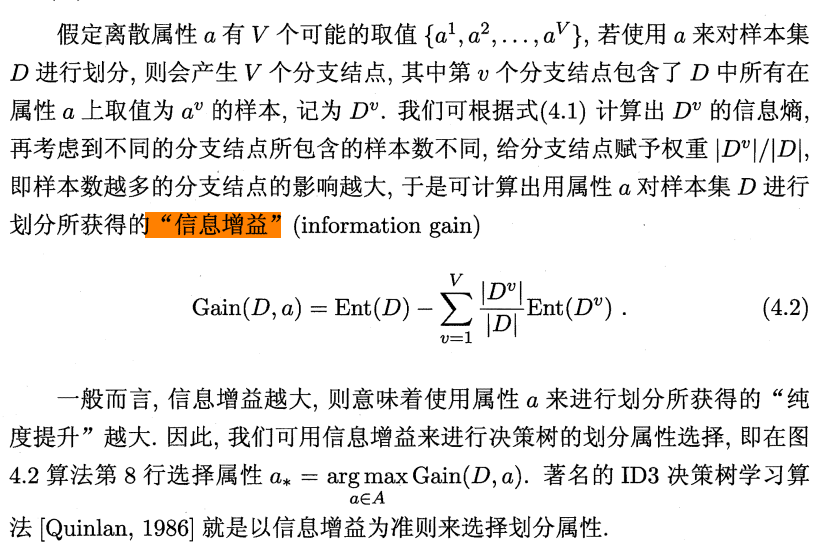
|Dv|代表a特征中同样是v值的样本的数量。
当前样本此特征的信息增益 = 当前样本的信息熵 - 加权求和的同特征值的样本的信息熵。
举个例子
西瓜数据集2.0如下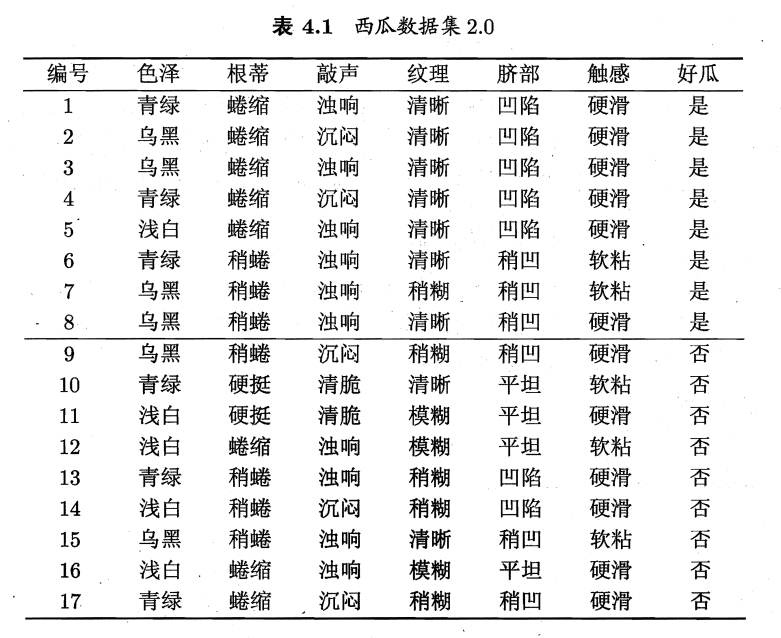
首先计算样本的信息熵
然后计算各个特征的信息增益
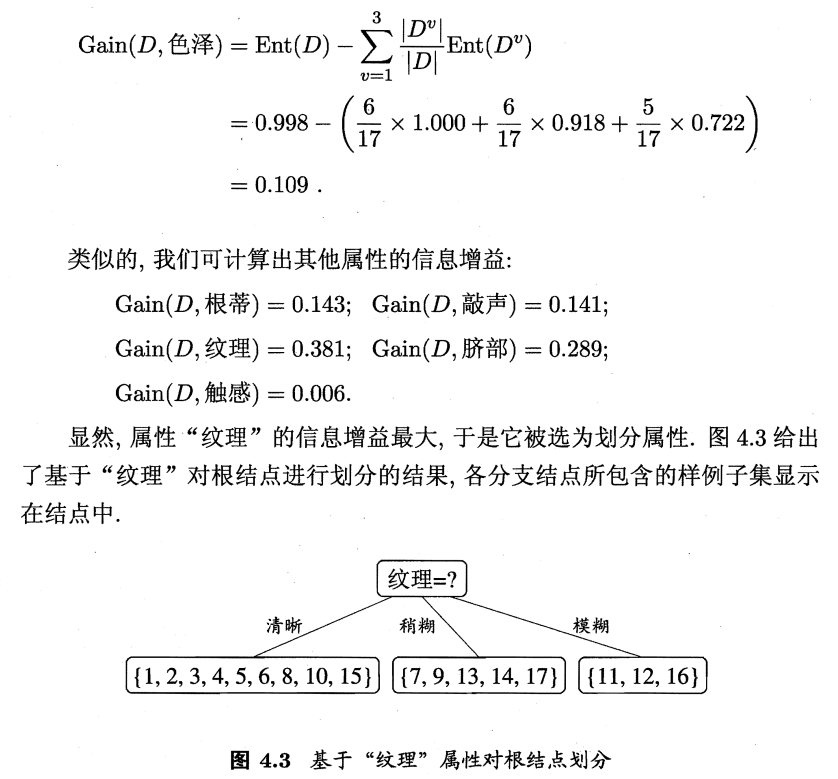
可见纹理的信息增益最大,也说明用纹理来划分当前数据,得到的纯度是最高的。
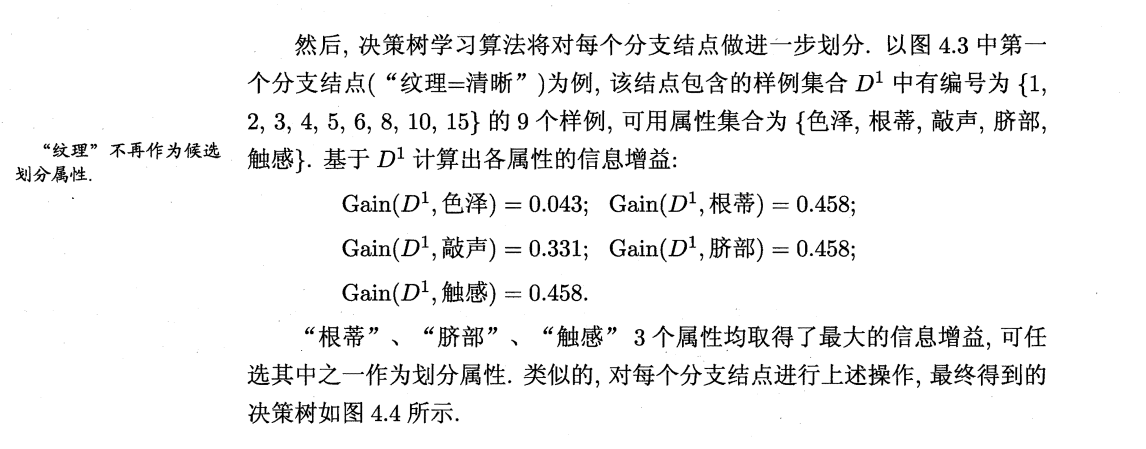
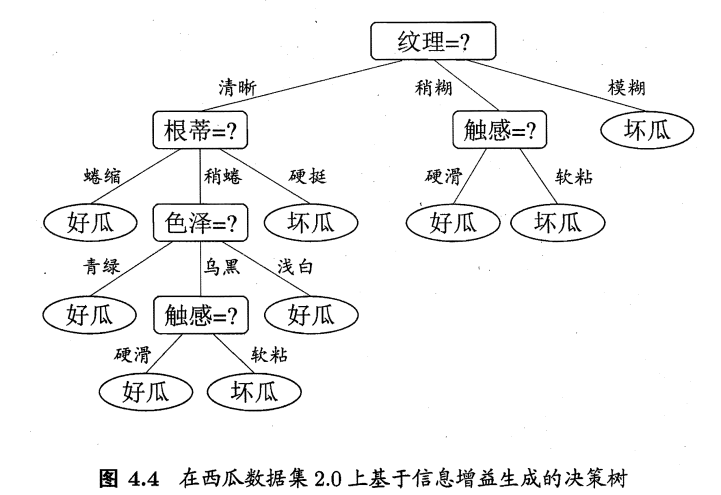
信息增益率
因为信息增益对可取值较多的属性有所偏好,为了减少这个影响,可以采用信息增益率。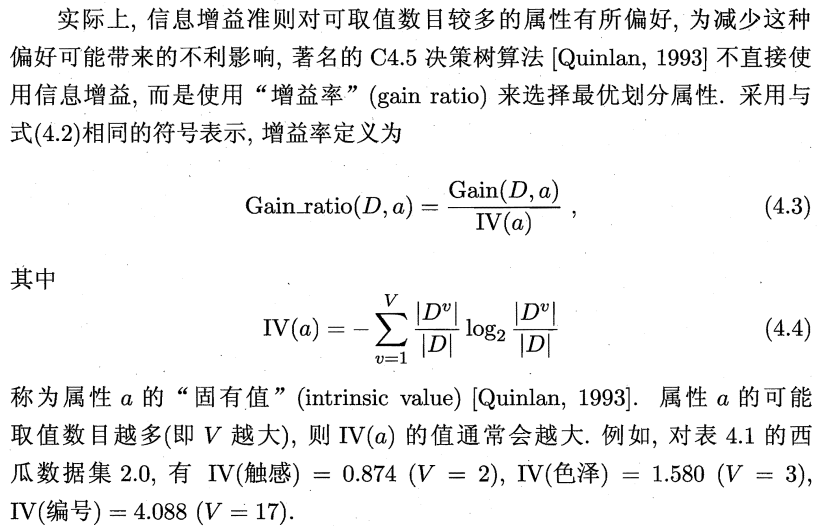
但是仍然存在问题:

基尼系数
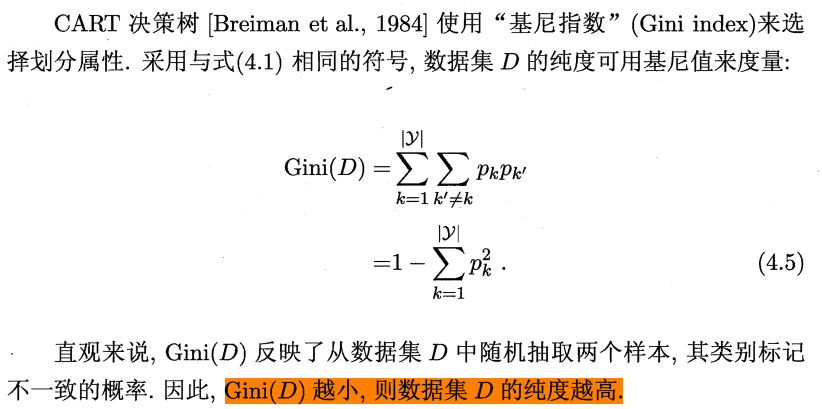
基尼指数

决策树代码实现
千言万语都在注释里了。
import math
import numpy
import numpy as np
import collections
from sklearn.model_selection import train_test_split
from sklearn import tree
from sklearn.tree import DecisionTreeClassifier # 导入决策树DTC包classDecisionNode(object):def__init__(self, f_idx, threshold, value=None, L=None, R=None):
self.f_idx = f_idx # 属性的下标,表示通过下标为f_idx的属性来划分样本
self.threshold = threshold # 下标 `f_idx` 对应属性的阈值
self.value = value # 如果该节点是叶子节点,对应的是被划分到这个节点的数据的类别
self.L = L # 左子树
self.R = R # 右子树# 寻找最优的阈值deffind_best_threshold(dataset: np.ndarray, f_idx:int, split_choice:str):# dataset:numpy.ndarray (n,m+1) x<-[x,y] f_idx:feature index
best_gain =-math.inf # 信息增益越小纯度越低
best_gini = math.inf # 基尼值越大纯度越低
best_threshold =None
candidate =[0,1]# 因为只有01,就用这两个来划分。候选值1代表是这个特征,0代表不是这个特征# 遍历候选值,找出纯度最大的划分值(这里是0或者1)for threshold in candidate:
L, R = split_dataset(dataset, f_idx, threshold)# 根据阈值分割数据集,小于阈值
gain =Noneif split_choice =="gain":# 计算信息增益
gain = calculate_gain(dataset, L, R)# 根据数据集和分割之后的数if gain > best_gain:# 如果增益大于最大增益,则更换最大增益和最大阈值
best_gain = gain
best_threshold = threshold
if split_choice =="gain_ratio":# 计算信息增益率
gain = calculate_gain_ratio(dataset, L, R)if gain > best_gain:# 如果增益大于最大增益,则更换最大增益和最大阈值
best_gain = gain
best_threshold = threshold
# 计算基尼指数if split_choice =="gini":
gini = calculate_gini_index(dataset, L, R)if gini < best_gini:# gini指数越小越好
best_gini = gini
best_threshold = threshold
# 返回此特征最优的划分值(0或1)以及对应的信息增益/增益率/基尼指数return best_threshold, best_gain
# 计算信息熵defcalculate_entropy(dataset: np.ndarray):# 熵
scale = dataset.shape[0]# 多少条数据
d ={}for data in dataset:# 一条数据的最后一位是标签
key = data[-1]# 统计数据类别个数if key in d:
d[key]+=1else:
d[key]=1
entropy =0.0for key in d.keys():# pk
p = d[key]/ scale
# -pk * log2(pk)
entropy -= p * math.log(p,2)return entropy
# 计算信息增益defcalculate_gain(dataset, l, r):# l:左子树的数据# r:右子树的数据# 计算信息熵
e1 = calculate_entropy(dataset)# 因为每个特征只有两种取值,是或不是(l,r已然是按特征分开的两类)
e2 =len(l)/len(dataset)* calculate_entropy(l)+len(r)/len(dataset)* calculate_entropy(r)
gain = e1 - e2
return gain
# 计算信息增益率defcalculate_gain_ratio(dataset, l, r):
s =0
gain = calculate_gain(dataset, l, r)
p1 =len(l)/len(dataset)
p2 =len(r)/len(dataset)# 会出现 1/0 的情况 全被划分到一边 s=0# 只有0,1两种取值if p1 ==0:
s = p2 * math.log(p2,2)elif p2 ==0:
s = p1 * math.log(p1,2)else:
s =- p1 * math.log(p1,2)- p2 * math.log(p2,2)# 如果s为0,说明全都划分到一类,信息增益率可以看成无限大if s ==0:
gain_ratio = math.inf
else:
gain_ratio = gain / s
return gain_ratio
# 计算基尼系数(随机抽取两个样本,其类别不一致的概率)defcalculate_gini(dataset: np.ndarray):
scale = dataset.shape[0]# 多少条数据
d ={}for data in dataset:
key = data[-1]if key in d:
d[key]+=1else:
d[key]=1
gini =1.0for key in d.keys():
p = d[key]/ scale
gini -= p * p
return gini
# 计算基尼指数,基尼指数越小,纯度越高defcalculate_gini_index(dataset, l, r):
gini_index =len(l)/len(dataset)* calculate_gini(l)+len(r)/len(dataset)* calculate_gini(r)return gini_index
defsplit_dataset(X: np.ndarray, f_idx:int, threshold:float):# 左边是f_idx特征小于阈值的数据# 右边是大于阈值的数据
L = X[:, f_idx]< threshold
R =~L
return X[L], X[R]defmajority_count(dataset):
class_list =[data[-1]for data in dataset]# 返回数量最多的类别return collections.Counter(class_list).most_common(1)[0][0]defbuild_tree(dataset: np.ndarray, f_idx_list:list, split_choice:str):# return DecisionNode 递归# f_idx_list 待选取特征的列表
class_list =[data[-1]for data in dataset]# 类别# 全属于同一类别(二分类)if class_list.count(class_list[0])==len(class_list):return DecisionNode(None,None, value=class_list[0])# 若属性都用完, 标记为数量最多的那一类eliflen(f_idx_list)==0:
value = collections.Counter(class_list).most_common(1)[0][0]return DecisionNode(None,None, value=value)else:# 找到划分 增益最大的属性
best_gain =-math.inf
best_gini = math.inf
best_threshold =None
best_f_idx =None# 遍历所有特征,找出纯度最大的那个特征for i in f_idx_list:
threshold, gain = find_best_threshold(dataset, i, split_choice)# 基尼指数越小纯度越大if split_choice =="gini":if gain < best_gini:
best_gini = gain
best_threshold = threshold
best_f_idx = i
# 信息增益/信息增益率越大,纯度越大if split_choice =="gain"or split_choice =="gain_ratio":if gain > best_gain:# 如果增益大于最大增益,则更换最大增益和最大
best_gain = gain
best_threshold = threshold
best_f_idx = i
# 拷贝原特征
son_f_idx_list = f_idx_list.copy()# 移除进行分类的特征(挑选出的最优特征)
son_f_idx_list.remove(best_f_idx)# 以最优阈值分割数据
L, R = split_dataset(dataset, best_f_idx, best_threshold)# 左边的数据为0那么说明已经全都为一类了,那么叶节点就产生了iflen(L)==0:
L_tree = DecisionNode(f_idx=None, threshold=None, value=majority_count(dataset))# 叶子节点# 否则就继续往下划分else:
L_tree = build_tree(L, son_f_idx_list, split_choice)# return DecisionNode# 右边也同理iflen(R)==0:
R_tree = DecisionNode(f_idx=None, threshold=None, value=majority_count(dataset))# 叶子节点else:
R_tree = build_tree(R, son_f_idx_list, split_choice)# return DecisionNode# 递归调用建树return DecisionNode(f_idx=best_f_idx, threshold=best_threshold, value=None, L=L_tree, R=R_tree)defpredict_one(model: DecisionNode, data):if model.value isnotNone:return model.value
else:
feature_one = data[model.f_idx]
branch =Noneif feature_one >= model.threshold:
branch = model.R # 走右边else:
branch = model.L # 走左边return predict_one(branch, data)defpredict_accuracy(y_predict, y_test):
y_predict = y_predict.tolist()
y_test = y_test.tolist()
count =0for i inrange(len(y_predict)):ifint(y_predict[i])== y_test[i]:
count = count +1
accuracy = count /len(y_predict)return accuracy
classSimpleDecisionTree(object):def__init__(self, split_choice):# split_choice 分割策略:信息增益、信息增益率或者基尼指数
self.split_choice = split_choice
deffit(self, X: np.ndarray, y: np.ndarray):
dataset_in = np.c_[X, y]# 纵向拼接
f_idx_list =[i for i inrange(X.shape[1])]# 特征列
self.my_tree = build_tree(dataset_in, f_idx_list, self.split_choice)# 建树defpredict(self, X: np.ndarray):
predict_list =[]for data in X:
predict_list.append(predict_one(self.my_tree, data))return np.array(predict_list)if __name__ =="__main__":
predict_accuracy_all =[]import pandas as pd
for i inrange(10):
data = pd.read_csv("data.csv")
y = data["label"].values
x = data.drop(columns="label").values
X_train, X_test, y_train, y_test = train_test_split(x, y, test_size=0.2)
predict_accuracy_list =[]# 储存4种结果
split_choice_list =["gain","gain_ratio","gini"]for split_choice in split_choice_list:
m = SimpleDecisionTree(split_choice)
m.fit(X_train, y_train)
y_predict = m.predict(X_test)
y_predict_accuracy = predict_accuracy(y_predict, y_test.reshape(-1))
predict_accuracy_list.append(y_predict_accuracy)
clf = DecisionTreeClassifier()# 所以参数均置为默认状态
clf.fit(X_train, y_train)# 使用训练集训练模型
predicted = clf.predict(X_test)
predict_accuracy_list.append(clf.score(X_test, y_test))
predict_accuracy_all.append(predict_accuracy_list)
p = numpy.array(predict_accuracy_all)
p = np.round(p, decimals=3)
accs =[]for i in p:
accs.append(i)
accs = pd.DataFrame(accs)
accs.columns =["gain","gain_ratio","gini","sklearn"]print(accs)
输出结果: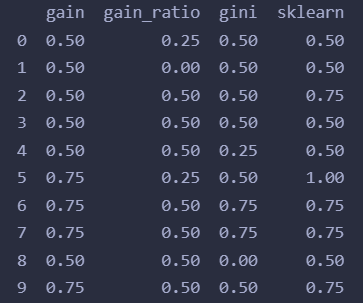
我们还可以可视化一下sklearn帮我们建立的决策树:
from sklearn import tree
import matplotlib.pyplot as plt
import matplotlib as mpl
mpl.rcParams['font.sans-serif']=['FangSong']# 指定中文字体
mpl.rcParams['axes.unicode_minus']=False# 解决保存图像是负号'-'显示为方块的问题
plt.rcParams['font.sans-serif']=['SimHei']
plt.rcParams['axes.unicode_minus']=False# 正常显示负号
fn=data.columns[:-1]
cn=['坏瓜','好瓜']
fig, axes = plt.subplots(nrows =1,ncols =1,figsize =(4,4), dpi=300)
tree.plot_tree(clf,
feature_names = fn,
class_names=cn,
filled =True);# value表示对应类别的样例分别有多少个。
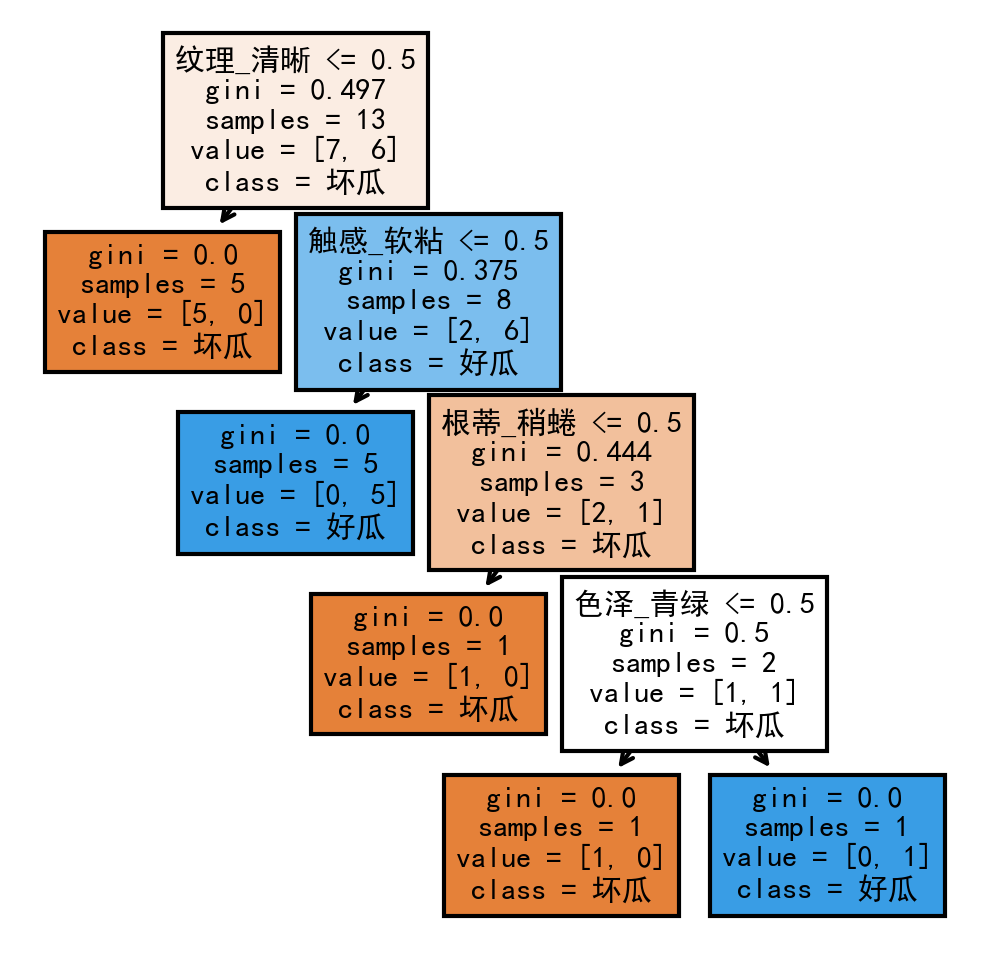
还是sklearn比较好。
参考
机器学习——周志华
手写分类决策树(鸢尾花数据集)
版权归原作者 Icy Hunter 所有, 如有侵权,请联系我们删除。